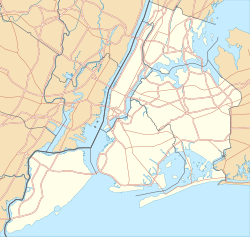John Bowne House
John Bowne House | |
 | |
| Coordinates | 40°45′46″N 73°49′32″W / 40.76278°N 73.82556°W |
|---|---|
| Area | 9 acres (3.6 ha) |
| Built | ca. 1661 |
| Architectural style | Anglo-Dutch Colonial |
| NRHP reference No. | 77000974[1] |
| Significant dates | |
| Added to NRHP | September 13, 1977 |
| Designated NYCL | February 15, 1966 |
The John Bowne House is an historic home important for its role in establishing religious tolerance located at 37-01 Bowne Street, Flushing, Queens, New York.
Built around 1661, it was the location of a Quaker meeting in 1662 that resulted in the arrest of its owner, John Bowne, by Peter Stuyvesant, Dutch Director-General of New Netherland. Bowne appealed his arrest successfully to the Dutch West India Company and established a precedent for religious tolerance and freedom in the colony. His appeal helped to serve as the basis for the later guarantees of freedom of religion, speech and right of assembly in the Constitution.
The Bowne House became a museum in 1947. After an exterior renovation, it has recently reopened on Wednesday afternoons and by appointment.
The home is a wood-frame Anglo-Dutch Colonial saltbox, notable for its steeply pitched roof with three dormers. The house was altered several times over the centuries, and several generations of the Bowne family lived in the house until 1945, when the family deeded the property to the Bowne Historical Society. The Bowne House reportedly served as a stop on the Underground Railroad prior to the American Civil War.[2][3][4][5]
Archaeological investigations have been conducted by Dr. James A. Moore of Queens College, City University of New York.[6]
It was listed on the National Register of Historic Places in 1977.[1] It is also a New York City landmark.
See also
- List of the oldest buildings in New York
- Peter Stuyvesant
- Flushing Remonstrance
- Religious tolerance
- John Bowne
- List of New York City Designated Landmarks in Queens
- National Register of Historic Places listings in Queens County, New York
References
- ^ a b "National Register Information System". National Register of Historic Places. National Park Service. March 13, 2009.
- ^ Glenn, Thomas Allen (1898–1900). Some Colonial Mansions and Those Who Lived in Them. Philadelphia, Pa.: H. T. Coates.
- ^ Haynes, Trebor (n.d. [1952?]). Bowne House: A Shrine to Religious Freedom. New York: Flushing Savings Bank.
{{cite book}}: Check date values in:|date=(help) - ^ Jackson, Kenneth T. (ed.). The Encyclopedia of New York City. New York: The New-York Historical Society. p. 133.
- ^ Elizabeth K. Ralph (March 1974). "National Register of Historic Places Registration: John Bowne House". New York State Office of Parks, Recreation and Historic Preservation. Archived from the original on 2012-10-18. Retrieved 2011-01-12.
{{cite web}}: Unknown parameter|deadurl=ignored (|url-status=suggested) (help) See also: "Accompanying six photos". Archived from the original on 2012-10-18.{{cite web}}: Unknown parameter|deadurl=ignored (|url-status=suggested) (help) - ^ Moore, James A. (2004). Putting People in the House: Bowne House Archaeology, 1997–2000. New Perspectives on the Bowne House: Archaeology and Architecture. Queensborough Public Library, Flushing Branch.
External links
 Media related to John Bowne House at Wikimedia Commons
Media related to John Bowne House at Wikimedia Commons- Official website
- Historic American Buildings Survey (HABS) No. NY-523, "Bowne House, 37-01 Bowne Street, Flushing, Queens County, NY", 33 photos, 18 measured drawings, supplemental material
J
- Houses completed in 1661
- Quaker meeting houses in New York City
- Houses on the National Register of Historic Places in New York City
- Historic American Buildings Survey in New York (state)
- Saltbox architecture
- Landmarks in Queens, New York
- Houses on the Underground Railroad
- Museums in Queens, New York
- Historic house museums in New York City
- Houses in Queens, New York
- Museums established in 1947
- 1947 establishments in New York (state)
- Flushing, Queens
- National Register of Historic Places in Queens, New York
- 1661 establishments in the Dutch Empire



